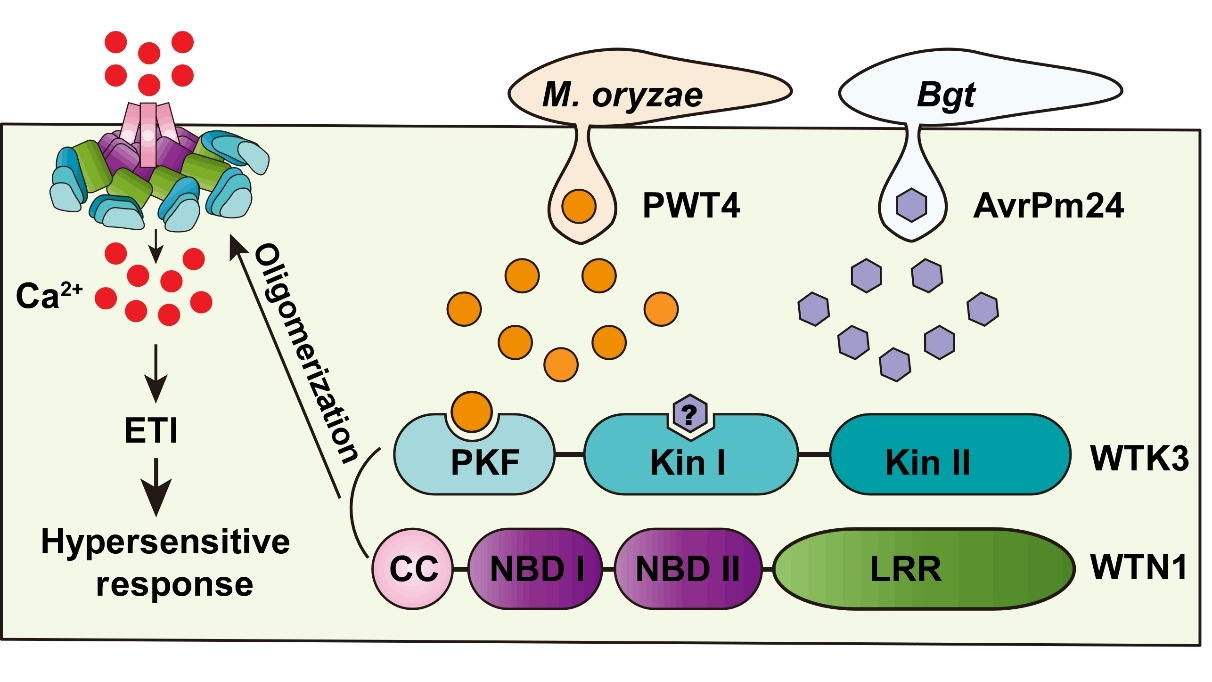

Working model for WTK3-WTN1 pair combating pathogens invasion. /IGDB
Recently the plant immunity team led by Professor Liu Zhiyong from the Institute of Genetics and Developmental Biology (IGDB), Chinese Academy of Sciences, along with collaborators from Nanjing Normal University, Yazhouwan National Laboratory, and Xianghu Laboratory, unveiled a novel immune mechanism by which tandem kinases combat pathogen invasion: an atypical NLR protein, WTN1 (Wheat Tandem NBD 1), partners with the tandem kinase WTK3 to detect pathogen effectors and initiate immune responses, thereby conferring resistance to multiple fungal diseases in wheat.
This research significantly advances the understanding of tandem kinase functionality, establishes a new paradigm for tandem kinase-NLR cooperation in disease resistance, addresses a critical gap in the immune regulatory pathways of tandem kinases, and provides a solid theoretical and practical foundation for the precise engineering of crop varieties with broad-spectrum and multi-pathogen resistance.
The work was published on Friday in Science under the title "A wheat tandem kinase and NLR pair confers resistance to multiple fungal pathogens."
Tandem kinase proteins (TKPs) represent a recently discovered class of disease resistance proteins in wheat and barley. Characterized by two or more tandemly arranged kinase domains, these proteins confer resistance to a range of fungal pathogens, including stripe rust, leaf rust, stem rust, powdery mildew, wheat blast, and smut, making them highly valuable for breeding applications. Previously, the plant immunity research group led by Liu at IGDB successfully cloned the broad-spectrum powdery mildew resistance genes Pm24 (WTK3, Nature Communications, 2020) and Pm36 (WTK7-TM, Nature Communications, 2024), which encode novel tandem kinases derived from Chinese wheat landraces and wild emmer wheat, respectively. Despite these advances, key scientific questions remain unanswered regarding these novel resistance proteins, such as the mechanisms by which tandem kinases recognize pathogen effectors (Avr), the functional roles of their distinct kinase domains in crop immunity, and the specific immune pathways through which tandem kinases activate disease resistance responses.
Through screening EMS-induced susceptible mutants of the powdery mildew resistance gene Pm24 (WTK3), the research team identified WTN1, a pivotal component of the WTK3-mediated disease resistance pathway. WTN1, an atypical NLR protein, is tightly linked to WTK3. Genetic analyses demonstrated that WTN1 is indispensable for WTK3-mediated immunity against wheat powdery mildew, with the WTK3-WTN1 pair activating immune responses via a sensor-executor cooperative model. Notably, WTK3 not only confers resistance to wheat powdery mildew but also recognizes the wheat blast effector PWT4, triggering immune responses and exhibiting potential resistance to wheat blast.

Development of novel high-yielding Pm24 germplasm via backcrossing and marker-assisted breeding. /IGDB
By employing a multidisciplinary approach – including plant immunology, biochemical assays, electrophysiological experiments, and evolutionary analysis – the team uncovered a closely coordinated relationship between WTK3 and WTN1, which enables wheat to combat pathogen invasion. Specifically, WTK3 features two critical functional modules: the first module, comprising the pseudo-kinase fragment (PKF) and the first kinase domain (Kinase I), is responsible for recognizing pathogen effectors, while the second kinase domain (Kinase II) interacts with the NLR protein WTN1, forming a robust "defense team." Upon detecting pathogens invasion, the WTK3-WTN1 complex is rapidly activated, forming an ion channel that facilitates calcium ion (Ca²⁺) influx, thereby inducing hypersensitive responses and programmed cell death.
Importantly, prior research has established that Pm24 (WTK3) is a unique genetic resource derived from Chinese wheat landraces. Through years of backcrossing and marker-assisted breeding, the team successfully introduced Pm24 into multiple high-yield wheat varieties, and the newly developed disease-resistant germplasms have been freely distributed to domestic institutions for breeding applications. These findings are anticipated to address the scarcity of broad-spectrum powdery mildew resistance genes in China's major wheat-producing regions, establish a potential genetic barrier against wheat blast, and provide essential theoretical and technical support for sustainable agricultural development and industrial upgrading.
This work was supported by the National Key R&D Program of China, the Strategic Priority Research Program of the Chinese Academy of Sciences, the National Natural Science Foundation of China, and the Youth Innovation Promotion Association of the Chinese Academy of Sciences. (CGTN)

86-10-68597521 (day)
86-10-68597289 (night)

52 Sanlihe Rd., Xicheng District,
Beijing, China (100864)

